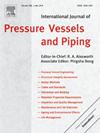On the use of tensile test time to adjust the time to rupture term in creep rupture life models whose stress term is normalized by tensile strength
IF 3
2区 工程技术
Q2 ENGINEERING, MECHANICAL
International Journal of Pressure Vessels and Piping
Pub Date : 2025-05-07
DOI:10.1016/j.ijpvp.2025.105543
引用次数: 0
Abstract
Creep life models which normalize stress by an ultimate tensile strength (UTS), such as the Wilshire equation, have a mathematical structure which results in the time to rupture being zero when the applied stress equals the UTS. However, the duration of a standard tensile test used to determine UTS is finite. Recently, two very different approaches to address this issue have appeared in the literature. In this study, these approaches are quantitatively compared by correlating them to the same set of creep rupture data with the Wilshire equation. Predicted times to rupture of each model are also compared with equivalent times to creep rupture of slow and fast constant strain rate tests performed on the same alloy, and the preferred method to account for finite tensile test times is identified.
用拉伸强度归一化应力项的蠕变断裂寿命模型中,用拉伸试验时间调整断裂项的时间
蠕变寿命模型通过极限拉伸强度(UTS)归一化应力,如Wilshire方程,具有数学结构,当施加应力等于UTS时,导致破裂时间为零。然而,用于确定UTS的标准拉伸试验的持续时间是有限的。最近,文献中出现了两种截然不同的方法来解决这个问题。在这项研究中,通过将这些方法与威尔希尔方程的同一组蠕变破裂数据相关联,对这些方法进行了定量比较。并将各模型的预测断裂次数与同一合金慢速和快速等应变速率试验的等效蠕变断裂次数进行了比较,确定了考虑有限拉伸试验次数的优选方法。
本文章由计算机程序翻译,如有差异,请以英文原文为准。
求助全文
约1分钟内获得全文
求助全文
来源期刊
CiteScore
5.30
自引率
13.30%
发文量
208
审稿时长
17 months
期刊介绍:
Pressure vessel engineering technology is of importance in many branches of industry. This journal publishes the latest research results and related information on all its associated aspects, with particular emphasis on the structural integrity assessment, maintenance and life extension of pressurised process engineering plants.
The anticipated coverage of the International Journal of Pressure Vessels and Piping ranges from simple mass-produced pressure vessels to large custom-built vessels and tanks. Pressure vessels technology is a developing field, and contributions on the following topics will therefore be welcome:
• Pressure vessel engineering
• Structural integrity assessment
• Design methods
• Codes and standards
• Fabrication and welding
• Materials properties requirements
• Inspection and quality management
• Maintenance and life extension
• Ageing and environmental effects
• Life management
Of particular importance are papers covering aspects of significant practical application which could lead to major improvements in economy, reliability and useful life. While most accepted papers represent the results of original applied research, critical reviews of topical interest by world-leading experts will also appear from time to time.
International Journal of Pressure Vessels and Piping is indispensable reading for engineering professionals involved in the energy, petrochemicals, process plant, transport, aerospace and related industries; for manufacturers of pressure vessels and ancillary equipment; and for academics pursuing research in these areas.

 求助内容:
求助内容: 应助结果提醒方式:
应助结果提醒方式:


